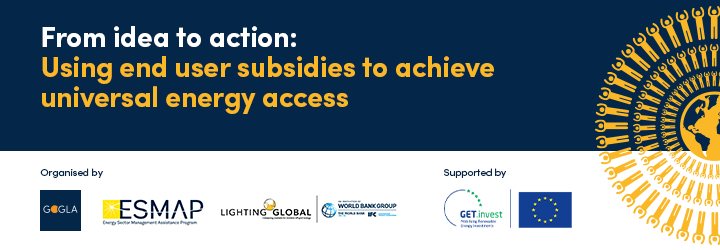Virtual Event | From idea to action: Using end-user subsidies to achieve universal energy access

The World Bank Group’s Lighting Global program, GOGLA, and ESMAP, supported by GET.invest, are pleased to invite you to our virtual event, ‘From idea to action: Using end-user subsidies to achieve universal energy access,’ on 20 January 2021.
Together, we will explore the role of end-user subsidies in the ‘tool-kit’ of pro-poor solutions as we work to accelerate energy access. The event will feature interactive discussions on end-user subsidies for stand alone solar technologies in four specific country scenarios.
Why is now the right time to talk about end-user subsidies?
Solar home systems, productive use equipment, mini grids, and other decentralized renewable technologies transform the lives and livelihoods of those living in energy poverty. The off-grid solar sector alone has enabled over 400 million people to purchase affordable renewable energy solutions and is expected to serve a further 600 million people by 2030. Yet, even before the COVID-19 pandemic, research showed that over 230 million people would be too poor to gain basic electricity access. The impacts from COVID-19 are expected to drive an additional 70 million people into extreme poverty – putting energy access even further out of reach for millions.
Rather than leave these communities behind, we must address the acute, and growing, “affordability gap”, to ensure they do not stay locked in energy poverty and universal energy targets are realized.
How end-user subsidies fit within the pro-poor toolkit?
The transformative impact of the decentralized renewable energy sector has been achieved largely by leveraging market dynamics. Public actors seeking to support energy access through off-grid have primarily provided supply side support, which indirectly bring down costs for end-users: companies receive support to reach rural and remote areas and to drive costs down through economies of scale. Supply-side subsidies, such as results-based financing (RBF) schemes, alongside supportive fiscal policies, and other market enablers, remain critical, allowing companies to charge a consistent price for their products, even when it costs them more to reach and service a customer. To achieve energy access goals, these solutions must be both continued and expanded.
However, to fully bridge the affordability gap, end-user subsidies that directly reduce energy costs for very low-income households, are needed. Examples include direct cash transfer, voucher schemes or RBF schemes that specifically enable or mandate that companies reduce product costs for very low income or vulnerable customers. These subsidies are complex in their design and bear a larger risk of market distortion. As such, they must be considered carefully within the broader mix of energy access dynamics and enablers and be designed very carefully.
Why you should join this event
This event aims to uncover practical solutions to end-user subsidy market and design challenges. Energy experts will explore how these subsidies fit within the ‘tool-kit’ of public financing solutions and discuss ‘smart design’ solutions for four pilot country programs in sub-Saharan Africa. Participants will be encouraged to contribute their own knowledge and experiences to the discussion to help identify practical ways to translate the idea of end user subsidies into action – bringing the sector one step closer to closing the energy access gap.
线上活动 | 从想法到行动:利用终端用户补贴实现能源普及

世界银行集团的点亮全球项目、全球离网太阳能协会(GOGLA)和能源部门管理援助计划(ESMAP),在 GET.invest 的支持下,荣幸地邀请您参加将于2021年1月20日举办的线上活动,主题为“从想法到行动:利用终端用户补贴实现能源普及”。
在我们努力加快能源普及工作的过程中,我们将共同探讨终端用户补贴在扶贫解决方案“工具包”中的作用。活动将围绕四个具体的国家项目背景,针对独立太阳能技术的终端用户补贴展开互动讨论。
为什么说现在是探讨终端用户补贴的正确时间?
太阳能家用系统、生产用太阳能设备、微型电网和其他分布式可再生技术改变了能源匮乏地区人口的生活和生计。单就离网太阳能行业,就已为超过4亿人口提供了可负担的的可再生能源解决方案,并预计到2030年将为6亿人口提供电力。然而,研究显示,即使在新冠肺炎疫情之前,仍有超过2.3亿人口因为贫困而无法获得基本的电力供应。新冠肺炎疫情的影响预计将导致新增7000万人口陷入极端贫困——无法获取能源的人口还会以百万计增加。
我们不能让该些群体掉队,相反我们必须解决日益严重和日益扩大的“负担能力差距”,以确保他们摆脱能源贫困,从而实现能源普及的目标。
终端用户补贴如何适用于扶贫工具包?
分布式可再生能源行业很大程度上通过利用市场动态已经实现具有变革性的影响力。寻求通过离网太阳能支持能源接入的公共部门,主要提供了供给侧的支持,这间接降低了终端用户的成本:企业得到支持后,得以进入农村和偏远地区,通过规模经济降低成本。包括基于结果的融资(RBF)在内的供给侧补贴、支持性财政政策,以及其他市场促进因素仍然至关重要,这些措施让企业能够为其产品确定一致的价格,即便触及和服务一个消费者会增加企业成本。为了实现能源普及的目标,这些解决方案必须得到延续和扩展。
然而,为了彻底弥合负担能力的差距,针对低收入家庭的终端用户,可以直接降低能源成本的补贴,是需要的。例如直接现金转帐、代金券计划或基于结果的融资计划,这些措施可以赋能或授权企业为低收入或弱势消费者降低产品成本。这些补贴在设计上十分复杂,并且存在更大的市场扭曲风险。因此,这些补贴的设计必须结合更广泛的能源接入动态和促进因素组合仔细考虑。
为什么这是一个值得参加的活动?
本次活动旨在为终端用户补贴市场和设计挑战找到切实可行的解决方案。能源专家将探讨这些补贴如何适用于公共融资解决方案的“工具包”,并讨论撒哈拉以南非洲地区四个试点的国家项目的“智能设计”解决方案。我们鼓励与会者在讨论中运用自己的知识和经验,助力寻找可以将终端用户补贴的想法转化为行动的有效方法,为缩小能源普及差距再向前迈出一步。

